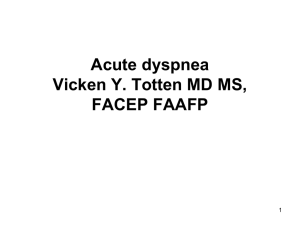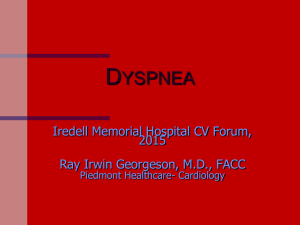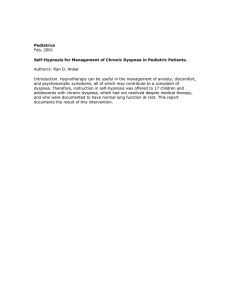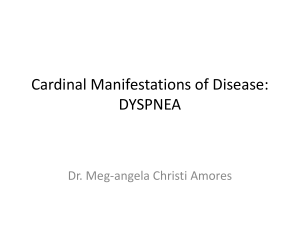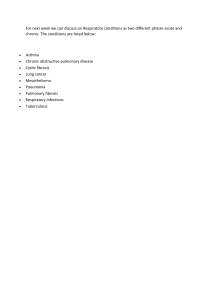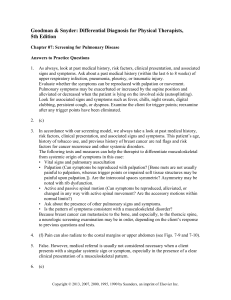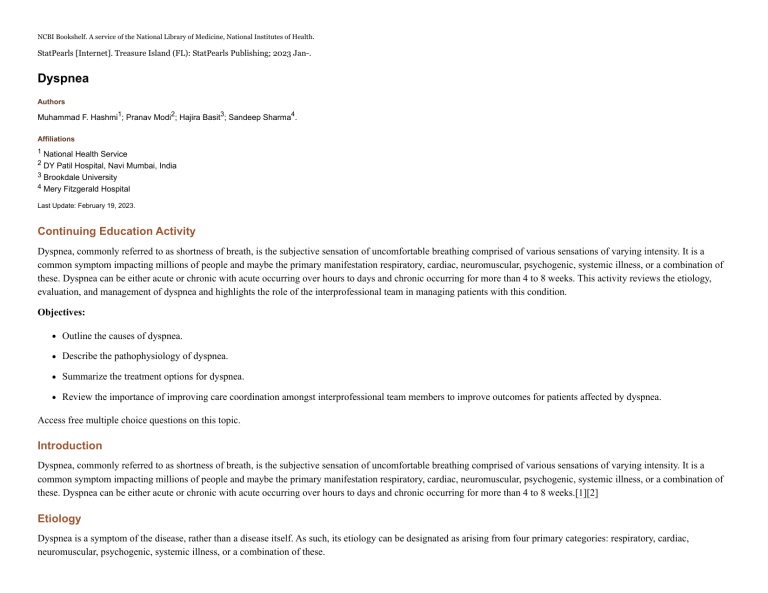
NCBI Bookshelf. A service of the National Library of Medicine, National Institutes of Health. StatPearls [Internet]. Treasure Island (FL): StatPearls Publishing; 2023 Jan-. Dyspnea Authors Muhammad F. Hashmi1; Pranav Modi2; Hajira Basit3; Sandeep Sharma4. Affiliations 1 National Health Service 2 DY Patil Hospital, Navi Mumbai, India 3 Brookdale University 4 Mery Fitzgerald Hospital Last Update: February 19, 2023. Continuing Education Activity Dyspnea, commonly referred to as shortness of breath, is the subjective sensation of uncomfortable breathing comprised of various sensations of varying intensity. It is a common symptom impacting millions of people and maybe the primary manifestation respiratory, cardiac, neuromuscular, psychogenic, systemic illness, or a combination of these. Dyspnea can be either acute or chronic with acute occurring over hours to days and chronic occurring for more than 4 to 8 weeks. This activity reviews the etiology, evaluation, and management of dyspnea and highlights the role of the interprofessional team in managing patients with this condition. Objectives: Outline the causes of dyspnea. Describe the pathophysiology of dyspnea. Summarize the treatment options for dyspnea. Review the importance of improving care coordination amongst interprofessional team members to improve outcomes for patients affected by dyspnea. Access free multiple choice questions on this topic. Introduction Dyspnea, commonly referred to as shortness of breath, is the subjective sensation of uncomfortable breathing comprised of various sensations of varying intensity. It is a common symptom impacting millions of people and maybe the primary manifestation respiratory, cardiac, neuromuscular, psychogenic, systemic illness, or a combination of these. Dyspnea can be either acute or chronic with acute occurring over hours to days and chronic occurring for more than 4 to 8 weeks.[1][2] Etiology Dyspnea is a symptom of the disease, rather than a disease itself. As such, its etiology can be designated as arising from four primary categories: respiratory, cardiac, neuromuscular, psychogenic, systemic illness, or a combination of these. Respiratory causes may include asthma, acute exacerbation of or chronic congestive obstructive pulmonary disorder (COPD), pneumonia, pulmonary Embolism, lung malignancy, pneumothorax, or aspiration. Cardiovascular causes may include congestive heart failure, pulmonary edema, acute coronary syndrome, pericardial tamponade, valvular heart defect, pulmonary hypertension, cardiac arrhythmia, or intracardiac shunting. Neuromuscular causes may include chest trauma with fracture or flail chest, massive obesity, kyphoscoliosis, central nervous system (CNS) or spinal cord dysfunction, phrenic nerve paralysis, myopathy, and neuropathy. Psychogenic causes may include hyperventilation syndrome, psychogenic dyspnea, vocal cord dysfunction syndrome, and foreign body aspiration. Other systemic illnesses may include anemia, acute renal failure, metabolic acidosis, thyrotoxicosis, cirrhosis of the liver, anaphylaxis, sepsis, angioedema, and epiglottitis. [3][4][5] Epidemiology The epidemiology of dyspnea is highly variable depending on etiology. Pathophysiology Dyspnea is a sensation of running out of the air and of not being able to breathe fast enough or deeply enough. It results from multiple interactions of signals and receptors in the CNS, peripheral receptors chemoreceptors, and mechanoreceptors in the upper airway, lungs, and chest wall. The respiratory center of the brain is comprised of 3 neuron groupings in the brain: the dorsal and ventral medullary groups and the pontine grouping. The pontine grouping further classifies into the pneumotaxic and apneustic centers. The dorsal medulla is responsible for inhalation; the ventral medulla is responsible for exhalation; the pontine groupings are responsible for modulating the intensity and frequency of the medullary signals where the pneumotaxic groups limit inhalation and the apneustic centers prolong and encourage inhalation. Each of these groups communicates the another to work together for pacemaking potential of respiration. Mechanoreceptors located in the airways, trachea, lung, and pulmonary vessels exist to provide sensory information to the respiratory center of the brain regarding the volume of the lung space. There are 2 primary types of thoracic sensors: slow adapting stretch spindles and rapid adapting irritant receptors. Slow-acting spindle sensors convey only volume information. However, the rapid-acting receptors respond to both volumes of the lung information and chemical irritation triggers such as harmful foreign agents that may be present. Both types of mechanoreceptors signal via cranial nerve X (the vagus nerve) to the brain to increase the rate of breathing, the volume of breathing, or to stimulate errant coughing patterns of breathing secondary to irritants in the airway. Peripheral chemoreceptors consist of the carotid and the aortic bodies. Both sites function to monitor the partial pressure of arterial oxygen in the blood. However, hypercapnia and acidosis increase the sensitivity of these sensors, thus playing a partial role in the receptor’s function. The carotid bodies are located at the bifurcation of the common carotid arteries, and the aortic bodies are located within the aortic arch. Once stimulated by hypoxia, they send a signal via cranial nerve IX (the glossopharyngeal nerve) to the nucleus tractus solatarius in the brain which, in turn, stimulates excitatory neurons to increase ventilation. It has been estimated that the carotid bodies comprise of 15% the total driving force of respiration. Central chemoreceptors hold the majority of control over respiratory drive. They function through sensing pH changes within the CNS. Primary locations within the brain include the ventral surface of the medulla, and the retrotrapezoid nucleus. The pH change within the brain and surrounding cerebrospinal fluid is derived primarily by increases or decreases in carbon dioxide levels. Carbon dioxide is a soluble lipid molecule that freely diffuses across the blood-brain barrier. This characteristic proves to be rather useful in that rapid changes in pH within the cerebrospinal fluid are possible. Chemoreceptors responsive to pH change are located on the ventral surface of the medulla. As these areas become acidic, sensory input is generated to stimulate hyperventilation, and carbon dioxide within the body is reduced through the increased ventilation. When pH rises to more alkalotic levels, hypoventilation occurs, and carbon dioxide levels decrease secondary to decreased ventilation. Respiratory centers located within the medulla oblongata and pons of the brainstem are responsible for generating the baseline respiratory rhythm. However, the rate of respiration is modified by allowing for aggregated sensory input from the peripheral sensory system which monitors oxygenation, and the central sensory system which monitors pH, and indirectly, carbon dioxide levels along with several other portions of the cerebellar brain modulate to create a unified neural signal. The signal is then sent to the primary muscles of respiration, the diaphragm, external intercostals, and scalene muscles along with other minor muscles of respiration.[6][7] History and Physical The history and physical exam should ascertain whether there are any ongoing cardiovascular, pulmonary, musculoskeletal, or psychiatric illnesses. Key components of the history to collect include onset, duration, and occurrence with rest or exertion. Presence of a cough may indicate the presence of asthma, chronic obstructive pulmonary disease (COPD), or pneumonia. A severely sore throat could indicate epiglottitis. Pleuritic quality chest pain may indicate pericarditis, pulmonary embolism, pneumothorax, or pneumonia. Orthopnea, nocturnal paroxysmal dyspnea, and edema suggest a possible diagnosis of congestive heart failure. Tobacco use is a common history finding that increases the likelihood of chronic obstructive pulmonary disease, congestive heart failure, and pulmonary embolism. If indigestion or dysphagia is present, consider gastroesophageal reflux disease or gastric secretion aspiration in the lungs. A barking quality cough, especially in children may suggest croup. Presence of fever strongly suggests an infectious etiology. The physical exam should begin with a rapid assessment of the ABCs (airway, breathing, and circulation). Once a patient is determined to be stable, a full physical exam can be done. To determine the severity of dyspnea, observe respiratory effort, use of accessory muscles, mental status, and speaking ability. Distention of the neck veins implies cor pulmonale caused by severe COPD, congestive heart failure, or cardiac tamponade. Thyromegaly may indicate hyperthyroidism or hypothyroidism. The tracheal deviation may indicate possible anatomic abnormality or pneumothorax. Auscultate for stridor in the upper airways indicates obstructed airway. Palpation of the chest can determine the presence of subcutaneous emphysema or crepitus. Percussion of the lung lobes for dullness can determine the presence or absence of consolidation and effusion. Hyperresonance on percussion is a worrisome finding that indicates possible pneumothorax or severe bullous emphysema. Lung auscultation may reveal absent breath sounds indicating the presence of pneumothorax or region occupying mass such as pleural effusion or malignancy. The presence of wheezing is highly consistent with the diagnosis of an obstructive lung disease such as asthma or COPD. However, wheezing may be associated with pulmonary edema or pulmonary embolism. Pulmonary edema and pneumonia may present with rales on auscultation. Auscultation of the heart may reveal the presence of dysrhythmia, cardiac murmurs, or aberrant heart gallops. An S3 gallop indicates cardiac overfilling seen in left ventricular systolic dysfunction and congestive heart failure. An S4 gallop suggests left ventricular dysmotility and dysfunction. A loud P2 indicates possible pulmonary hypertension. Murmurs may indicate valvular dysfunction. Diminished heart sounds may indicate cardiac tamponade. Pericarditis may present with a rubbing cardiac sound on auscultation. On abdominal examination, hepatomegaly, ascites, positive hepatojugular reflux may indicate the diagnosis of congestive heart failure. Lower extremities edema is associated with congestive heart failure, and extreme swelling of the extremities suggest possible deep venous thrombosis that can lead to a pulmonary embolism. Digits clubbing is present in some forms of lung malignancy or severe chronic hypoxia. Cyanosis of the extremities indicates hypoxia.[8][3][9] Evaluation Every evaluation should begin with a rapid assessment of the ABC status of the patient. Once these are determined to be stable, and no life-threatening status present, a complete history, and physical exam can be collected. Vital signs should be assessed for heart rate, respiratory rate, body temperature, body mass index (BMI), and oxygen saturation. Fever may indicate an infectious etiology. A chest x-ray is the first diagnostic test that should be utilized in evaluating dyspnea. If abnormal the disease process is likely cardiac or a primary pulmonary process. An echocardiogram is needed to evaluate cardiac function and valvular function. Additionally, an electrocardiogram should be obtained to evaluate for myocardial infarction or right-sided heart pattern strain. Elevated pro-BNP levels can further a congestive heart disease diagnosis. If the chest x-ray is normal, then spirometry is needed to determine lung function. Abnormal spirometry can indicate either an obstructive pathology such as asthma, COPD, or physical airway obstruction or restrictive disease processes such as interstitial fibrosis. Spirometry can also indicate the presence of respiratory muscle weakness from muscular or neurological abnormalities. Normal spirometry indicates a need to evaluate for hypoxia as a source of dyspnea. Arterial blood gas testing is used for this purpose as well as to calculate the A-a gradient and assess for an acidotic state. If hypoxic at PaO2 less than 70 mm Hg a V/Q scan is needed. Detection of a mismatch indicates pulmonary embolism. If a pulmonary embolism is clinically suspected, d-Dimer testing may be pursued, but this test has a low specificity and a high sensitivity and should be only used in high clinical suspicion of deep vein thrombosis or pulmonary embolism. Spiral CT of the chest is an alternative to V/Q scanning. A normal scan necessitates cardiac catheterization to determine pulmonary hypertension, intracardiac shunting, or coronary artery disease. A normal cardiac catheterization diagnosis idiopathic dyspnea. If hypoxia is not present with a PaO2 greater than 70 mm Hg, correlation with oxygen saturation is needed. Abnormal oxygen saturation indicates possible carbon monoxide poisoning methemoglobinemia or an abnormal hemoglobin molecule. Normal oxygen saturation requires a complete blood count (CBC) to evaluate hemoglobin content and hematocrit values. The white blood count also assesses for an immune response to possible infection. Hematocrit less than 35% is anemia. Hematocrit greater than 35% necessitates evaluation with exercise pulmonary function testing. Abnormal pulmonary function testing indicates a fixed cardiac output or exercise-induced asthma. Normal exercise pulmonary function testing indicates deconditioning, psychogenic dyspnea, or a hypermetabolic state. If an infectious etiology is suspected, culturing of the organism from the infected site should be attempted. In pneumonia, this is via sputum culture or bronchoalveolar lavage. In systemic infections or sepsis, this is via serial blood culture. Culture allows for appropriate targeted antibiotic therapy. Testing should be targeted toward clinical suspicion, history, and physical exam to avoid over-testing and minimize cost to the patient.[10][11][12][13] Treatment / Management Acute dyspnea typically is due to a more life-threatening process and requires rapid intervention. All patients should be placed on supplemental oxygen, pulse oximetry, and a cardiac monitor. Then the appropriate therapy should be initiated based on the suspected or diagnosed etiology. If respiratory failure is imminent, there should be a low threshold for intubating patients. Diagnostic workup should be performed only once appropriate, and the patient is stable.[14][15] Differential Diagnosis Acute dyspnea is most likely caused by acute myocardial ischemia, heart failure, cardiac tamponade, bronchospasm, pulmonary embolism, pneumothorax, pulmonary infection in the form of bronchitis or pneumonia, or upper airway obstruction by aspiration or anaphylaxis. Chronic dyspnea is most likely caused by asthma, chronic obstructive pulmonary disease, Interstitial lung disease, myocardial dysfunction, obesity, or deconditioning.[16] Prognosis In itself, dyspnea is harmless. However, it is a symptom, not an illness. Therefore, the prognosis is highly variable depending on the exact etiology and patient demographics. Enhancing Healthcare Team Outcomes Acute dyspnea is usually a medical emergency and is best managed by an interprofessional team that includes the emergency department physician, internist, pulmonologist, intensivist, radiologist and nurse practitioner. The cause of dyspnea must be identified and treated, otherwise the patient may develop respiratory failure and/or death. Review Questions Access free multiple choice questions on this topic. Comment on this article. References 1. Lee SH, Yeo Y, Kim TH, Lee HL, Lee JH, Park YB, Park JS, Kim YH, Song JW, Jhun BW, Kim HJ, Park J, Uh ST, Kim YW, Kim DS, Park MS., Korean Interstitial Lung Diseases Study Group. Korean Guidelines for Diagnosis and Management of Interstitial Lung Diseases: Part 2. Idiopathic Pulmonary Fibrosis. Tuberc Respir Dis (Seoul). 2019 Apr;82(2):102-117. [PMC free article: PMC6435928] [PubMed: 30841014] 2. Patel PH, Mirabile VS, Sharma S. StatPearls [Internet]. StatPearls Publishing; Treasure Island (FL): Aug 28, 2022. Wheezing. [PubMed: 29494061] 3. Brinkman JE, Toro F, Sharma S. StatPearls [Internet]. StatPearls Publishing; Treasure Island (FL): Jun 8, 2022. Physiology, Respiratory Drive. [PubMed: 29494021] 4. Zhang L, Ai T, Wang L, Zhang L, Zhang Y. Hypoplasia of the left lung presenting as hemoptysis: A case report. Medicine (Baltimore). 2019 Jan;98(4):e14077. [PMC free article: PMC6358385] [PubMed: 30681564] 5. Mejia R, Ward J, Lentine T, Mahler DA. Target dyspnea ratings predict expected oxygen consumption as well as target heart rate values. Am J Respir Crit Care Med. 1999 May;159(5 Pt 1):1485-9. [PubMed: 10228115] 6. Meriggi F. Dyspnea in Cancer Patients: A Well-Known and Neglected Symptom. Rev Recent Clin Trials. 2018;13(2):84-88. [PubMed: 29577864] 7. Mammadli A, Kılıçkap M, Dinçer İ, Akbulut İM, Sayın T. Heart failure due to aorto-right atrial fistula and successful treatment with percutaneous closure. Turk Kardiyol Dern Ars. 2019 Jan;47(1):60-62. [PubMed: 30628903] 8. Brinkman JE, Sharma S. StatPearls [Internet]. StatPearls Publishing; Treasure Island (FL): Jul 18, 2022. Physiology, Pulmonary. [PubMed: 29494033] 9. Ayers ML, Mejia R, Ward J, Lentine T, Mahler DA. Effectiveness of salmeterol versus ipratropium bromide on exertional dyspnoea in COPD. Eur Respir J. 2001 Jun;17(6):1132-7. [PubMed: 11491155] 10. Gillespie ND, McNeill G, Pringle T, Ogston S, Struthers AD, Pringle SD. Cross sectional study of contribution of clinical assessment and simple cardiac investigations to diagnosis of left ventricular systolic dysfunction in patients admitted with acute dyspnoea. BMJ. 1997 Mar 29;314(7085):936-40. [PMC free article: PMC2126385] [PubMed: 9099117] 11. Williamson A, Beckett D, Arestis N. A young breathless patient. Acute Med. 2018;17(1):49. [PubMed: 29589606] 12. Sharma S, Hashmi MF, Burns B. StatPearls [Internet]. StatPearls Publishing; Treasure Island (FL): Aug 22, 2022. Alveolar Gas Equation. [PubMed: 29489223] 13. Brinkman JE, Sharma S. StatPearls [Internet]. StatPearls Publishing; Treasure Island (FL): Jul 25, 2022. Respiratory Alkalosis. [PubMed: 29489286] 14. Schulz R, Gerke C, Stein S, Specht MB, Hirche TO. [Nocturnal dyspnea]. MMW Fortschr Med. 2018 Apr;160(6):43-46. [PubMed: 29619694] 15. Parshall MB, Schwartzstein RM, Adams L, Banzett RB, Manning HL, Bourbeau J, Calverley PM, Gift AG, Harver A, Lareau SC, Mahler DA, Meek PM, O'Donnell DE., American Thoracic Society Committee on Dyspnea. An official American Thoracic Society statement: update on the mechanisms, assessment, and management of dyspnea. Am J Respir Crit Care Med. 2012 Feb 15;185(4):435-52. [PMC free article: PMC5448624] [PubMed: 22336677] 16. Quinn M, St Lucia K, Rizzo A. StatPearls [Internet]. StatPearls Publishing; Treasure Island (FL): Feb 19, 2023. Anatomy, Anatomic Dead Space. [PubMed: 28723045] Disclosure: Muhammad Hashmi declares no relevant financial relationships with ineligible companies. Disclosure: Pranav Modi declares no relevant financial relationships with ineligible companies. Disclosure: Hajira Basit declares no relevant financial relationships with ineligible companies. Disclosure: Sandeep Sharma declares no relevant financial relationships with ineligible companies. Copyright © 2023, StatPearls Publishing LLC. This book is distributed under the terms of the Creative Commons Attribution-NonCommercial-NoDerivatives 4.0 International (CC BY-NC-ND 4.0) ( http://creativecommons.org/licenses/by-nc-nd/4.0/ ), which permits others to distribute the work, provided that the article is not altered or used commercially. You are not required to obtain permission to distribute this article, provided that you credit the author and journal. Bookshelf ID: NBK499965 PMID: 29763140
